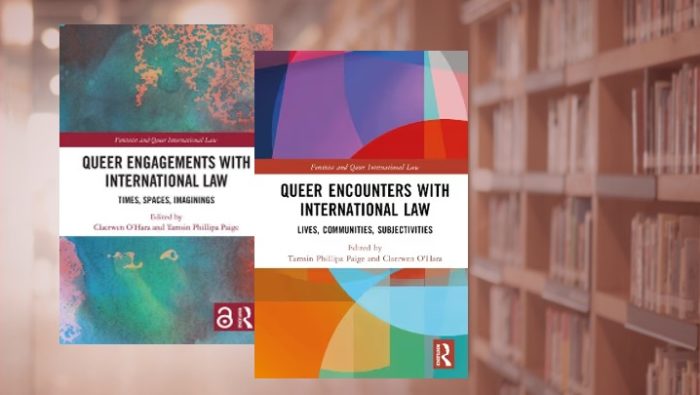
Que(e)rying International Law

How do we queer international law? Who/what are the “queer” subjects of international law? Why should we pursue queer entanglements with international law?
International law as a field is in crisis. It faces scrutiny for its colonial applications and inability to hold states accountable for mass atrocities, such as the Israeli genocide in Gaza. Making sense of international laws’ failures and possibilities in this context is an urgent task. We can turn to “queer” for this. In her book, Dianne Otto argues that a queer analysis of international law invites us to “take a break” from demands for equal rights or sexual normativity, and encourages us to pursue a “queer curiosity” that foregrounds pleasure, diversity, and fluidity to disrupt binary understandings of sex, gender, and sexuality (p. 1). Claerwen O’Hara and Tamsin Phillipa Paige’s take up Otto’s invitation in their compelling sibling edited collection set, Queer Engagements with International Law: Times, Spaces, Imaginings and Queer Encounters with International Law: Lives, Communities, Subjectivities. These texts make an important contribution to the field by using the queer/law contestation as a methodological tension which enables critical socio-legal scholars to rethink how international law deals with the lives of LGBTIQA+ people, as well as que(e)ry the politics of international law.
Queer/ing international law neither abandons the importance of reflexive critique, nor the value of normative pursuits for justice. O’Hara and Paige write that their edited collections “constitute a ‘re-queering’ of international law for our present moment, reflecting the non-linear, plural, and unfinished nature of queer legal theories and their encounters with international law” (Queer Encounters, p. 7). Across 24 chapters in two volumes, this “re-queering” is done by a range of critical international legal scholars navigating rich terrains.
Queer Encounters with International Law attends to LGBTIQA+ people in their encounters with international law, covering the problematic medicalisation of trans people (such as in European Convention of Human Rights jurisprudence), failure to recognise non-normative sexual practices (such as sadomasochism), and refusal to countenance childhood sexual and gender non-normativity (such as sex education in schools).
The sibling collection, Queer Engagements with International Law, directs our attention beyond encounters with gender and sexual minoritisation to think about how “queer” might disrupt spaces, temporalities, and imaginings of international law. This volume “mov[es] beyond queer theory’s site of origin” (non-normative gender and sexuality) to consider varied geographic terrains like oceans, mountains, and outer space alongside forms of kinship like cultural heritage, adjudication, and conferencing (Queer Engagements, p. 10).
Each contribution adopts a different object of study (transphobic judgments, dispossession of Indigenous knowledges in legal analysis) or method of critique (doctrinal analysis, empirical research, cultural theory), but shares a reparative orientation. The authors across both volumes are motivated by a desire to redress the continuing marginalisation of LGBTIQA+ people (alongside environments and animals) that emerge through state practices like law and policy. This includes practices that criminalise homosexuality, erase trans and non-binary existence, police non-normative sexual expression, pollute and pillage the environment, and facilitate capitalist competition. By refusing this, we are invited to “re-defin[e] the subject [of international law] as one that embraces both human and non-human kin” (Queer Engagements, Jones p. 37) and explore “ways of being [that] can contribute to pushing the boundaries of what might be, at present, unimaginable” in international law (Queer Encounters, Mazel p. 223).
In making room to recognise institutional and interpersonal violence perpetrated against LGBTIQA+ people, including within legal arenas, the contributors to these volumes caution us (as legal scholars and advocates) against embracing a penal politics of international human rights law that reproduce structural inequalities. Caitlin Biddolph, for example, examines the work of the International Criminal Tribunal for the Former Yugoslavia and indicts the inability of international criminal law to “provide inclusive, open, and fluid possibilities for people in the wake of violence” (Queer Engagements, p. 159). Giovanna Gilleri problematises the way international human rights law conceptualises sexual violence in terms that obscure the “infinite combinations of gendered victims and perpetrators” (Queer Encounters, p. 161). From these critiques, it becomes clearer that “LGBT human rights advocates should seize this opening to expand their reparative imaginations… with an explicit aim of countering the carceral logics that dominate human rights law and advocacy” (Queer Encounters, Engle p. 83). We need to temper our desire for punishment and certainty with reflexive care and critique.
Making this analytic shift as queer scholars is hopeful and messy, involving “repeatedly, and sometimes slowly and painstakingly, expos[ing] [international law’s] impossibility and out-of-reachness as a practice for generative rupture” (Carvalho, Queer Encounters, p. 220). Queer judging is an example of this undertaking, where we (as judges) strive towards what is out of reach. Queer judging is a set of “performative acts [that] create both possibilities and constraints” as the queer judge seeks to (re)interpret law in a way that attends to fluidity and diversity while remaining faithful to a judicial role that requires the assertion of normative authority (Queer Engagements, Stagg p. 190).
So where does this leave the (impossible) task of que(e)rying international law for social repair?
We can take inspiration from Loveday Hodson who reminds us that “in navigating through despair and hope” we might “find a way to live queerly and ambivalently with rights” (Queer Encounters, p. 253). Danish Sheikh adds, “a reparative ethos suggests that we might do repair better if we are able to conduct repair-work together” (Queer Engagements, p. 211). This involves foregrounding “stories from geontologically different lifeworlds and temporal orders” to showcase how decolonial ideas and non-Westernised communities engage with, and critique, law in everyday life (Queer Engagements, Hamzić p. 97). After all, the “construction of international law and international relations do not remain in the exclusive province of the courts” (Queer Engagements, Tugade p. 137).
These scholars remind us that the stories, sources, and silences of international law are as plural as they are productive. This means we should make, undo, play, resist, and rupture international law in ways that support planetary flourishing. Queer Encounters with International Law and Queer Engagements with International Law beautifully generate ideas that lead us there.

